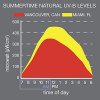Damn bro! Thanks, that's some awesome information right there. So in veg run it the equivalent of 11am-2pm and then in flower build it up until 12 of the 12 hours of light for last four weeks. I'm on it...
Yea, I'm starting to use it already in veg because I want they get used to it from the beginning. With a reptile bulb you can literally use it all the time but it's not needed and wasted energy. In nature they get also only UVB for a few hours.
I've started with 3h when main lights go on and 3h before it goes out again and a distance of 12"/1ft. This way they have a 6h break to recover. In bloom stage I would increase it from the third week to 12/12h simply because the resin production begins around the third week.
The Agromax bulbs are at least 4 times stronger like
@Airwalker16 metioned ealier in the thread! I'll start using it for the same 3+3h but with 24"/2ft distance to get almost the same UVB intensity I got from the reptile bulb at 12"/1ft.(~170μW/cm²).
From this point I'll lower the distance slowly to 16-18" which is my prefered hanging hights for the LED fixture(see signature below). Intensity should go up to 200-250μW/cm². If I see no signs of stress like burned leaf margins and tips or curled leafes I will increase the time when it's on until they get stress. But with an Agromax PureV I can easily imagine that this is already too much. It's like try and error to figure out how much is needed and what is already too much. A equatorial sative or an indika strain from hindukush can probably handle more UV like a HollandsHope.
If you carry a fiber hemp strain with only 0.3% thc for example to jamaica and continue breeding it for several generations you will find that it becomes more and more potent again. The exact opposite happens when you bring potent strains like jamaican lambsbreed into the northern hemispheres. They will loose potency over the time.
All because more or less UV radiation!!! No effect..?! Bullshit!
Not for nothing the most potent varieties come from places with highest UVB intensity.
At 2000m above 0 you can easily measure over 1000μW/cm² timewise.

